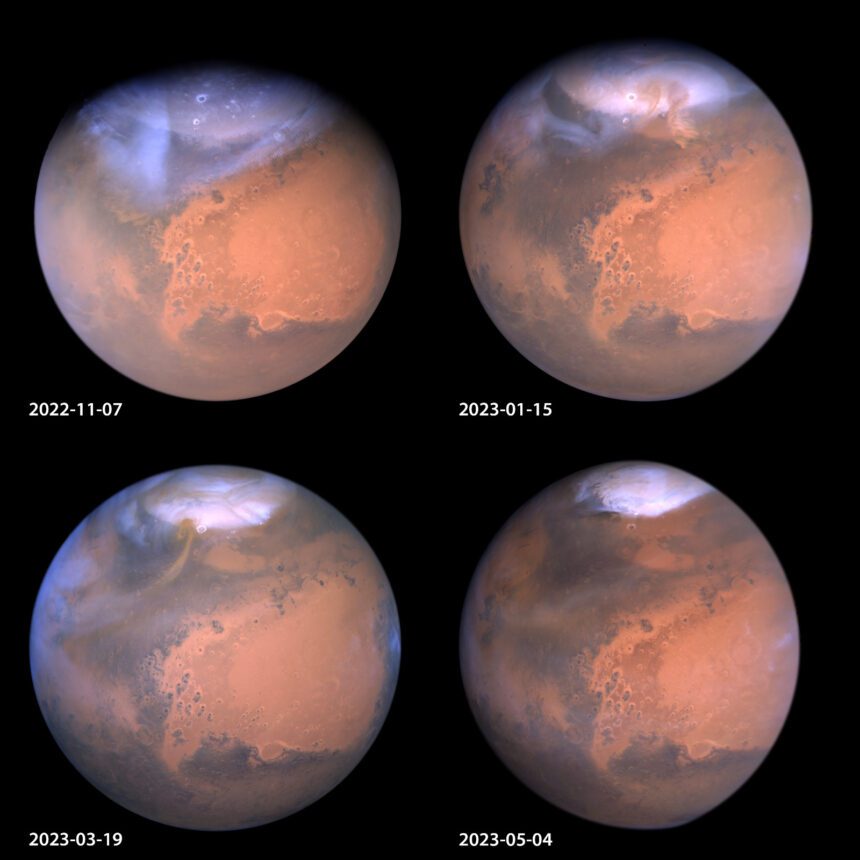The Emirates Mars Mission has released the eighth batch of scientific data on the Martian atmosphere.
In fact this provides important developments that enhance our understanding of the weather on the Red Planet.
The latest set of data adds to the critical insights of previously released data sets on the transition between Martian seasons.
By covering the end of the dust storm season on the planet with the entry of a new year during the spring equinox in the northern hemisphere.
The scientific team of the Emirates Mars Mission has confirmed the uniqueness of this great achievement.
Since its reflects the efficiency of the probe in providing daily coverage that no other mission has been able to achieve during this extended period.
Due to the fact that the scientific team can monitor seasonal changes on the Red Planet and analyze them.
The team highlighted the importance of the data, explaining that although the expected climate changes on Mars are known,
there are some subtle differences that are still beyond our understanding.
there are some subtle differences that are still beyond our understanding.
During the extended mission, we will work to analyze these subtle differences, focusing on the differences between years.
As well as collecting more observations related to morning-to-evening fluctuations, among other factors.
For sure these new observations will enable scientists and researchers to deepen their study of seasonal changes on Mars.
Besides gaining a deeper understanding of annual changes.
The Hope Probe is the first mission to provide daily accurate coverage of weather conditions.
Noting that the mission provides coverage from the surface to the edge of the Martian atmosphere.
The eighth batch of data, which was collected between December 1, 2022, and February 28, 2023, for Level 1 and 2 data.
In addition to September 1, 2022, to November 30, 2022, for Level 3 data, includes a set of high-resolution observations of cloud movement.
(December 28, 2022, January 6, 15, and 31, 2023, February 7, 12, and 23, 2023) and dust movement (December 4, 5, and 18, 2022).
The images and rich data collected by the infrared spectrometer (EMIRS), the ultraviolet spectrometer (EMUS).
As well as the digital exploration camera (EXI) will provide valuable insights for scientists and researchers.
So they can understand the different atmospheric factors on Mars and their effects on its climate and environment.
Also, this batch includes, for the first time, Level 3 halo products from the EMUS.
Which contain information on the distribution of extended clouds of hydrogen and oxygen atoms surrounding Mars and their escape into space.
With the eighth batch of data, the Hope Probe has revealed a large amount of data on the Martian atmosphere.
Mentioning that the amount of data is about 2.9 terabytes Since the Hope Probe reached its orbit.
Its clear that the Emirates Mars Mission has made significant contributions to the international scientific community.
Its clear that the Emirates Mars Mission has made significant contributions to the international scientific community.
Since it has published 18 scientific research papers in prestigious international journals.
Obviously the research papers support the studies of researchers and scientists around the world.
Also promotes the growth of research conducted by Emirati students, scientists, and researchers.
The Hope Probe has also achieved historical achievements.
Since it has taken unprecedented observations of Mars’ smaller moon, Deimos, which were captured using the probe’s three scientific instruments.
This was during its closest approach to the moon at a distance of only about 100 kilometers.
Which is the closest distance to the moon for a spacecraft since the Viking mission in 1977.
You can also read:
The UAE Leading Middle East Space Field
AI is a new competitive sector in real estate markets
UAE Expands Clean Tech Usage to Face Climate Change.
The UAE topped Forbes list: “20 Women Behind Middle Eastern Tech Brands”





